In the last couple of issues I’ve cast the net pretty wide in regards to selecting the correct fishing craft for the job. Initially I covered vital issues such as freeboard, sea keeping capability, ride quality and fishing room, as these are essential considerations in selecting a just-right rig for most fishing activities an angler might have in mind.
I also pointed out that all boats will involve some compromises that the owner will need to work around. That aside, the smart angler doesn’t go out and just buy a boat. The idea is to work out what sort of fishing lifestyle you want and then select the craft.
In last month’s issue I highlighted one of the most important decisions you might make – whether to opt for alloy or fibreglass in the final cut. While emphasizing the fact that I would not be making an alloy versus glass debate, I did point out quite a few benefits (plus a couple of drawbacks) of owning an alloy – pressed sheet or plate – craft covering everything from carefree operation through to more bang for the buck, as well as some of the downsides of the deal.
Let’s face it: glass boats have been around for a very long time so they must have something pretty good going for them! First is the ride. There can be no denying it – these hulls are formed into shapes that enhance ride quality and sea keeping as well other important features of a good boat.
Here’s why: fibreglass hulls are laid up within a mould (actually there areseveral moulds) to form all sorts of complex curves and shapes purpose-designed to offer what the manufacturer considers the ultimate in ride, handling attributes and interior features. So while the hull’s moulds might take a lot of hours to form and set up once they are completed the basic hull and other important bits and pieces can be turned out when needed.
The glass manufacturer has a lot of latitude with hull forming. Keeping the fibreglass to the minimum (while still maintaining adequate strength) will reduce weight. Add more glass in layers and the hull will be thicker, stronger and heavier, either way the beautiful eye catching lines will always be there!
Aluminium, on the other hand, has limits regarding shaping, forming and stretching. While computer designing, programming and new manufacturing techniques have lifted alloy craft to new levels today, the material itself has limits for forming angles and final shaping that glass doesn’t, as aluminium is formed in a fluid state.
The major result of the two differing manufacturing processes comes down to glass hulls having softer and more pronounced lines depending upon what the manufacturer wants. The reality is that any shape, angle or curve is possible with glass construction.
Denser material also means more weight. Fibreglass craft will usually be heavier, which is no drawback as a heavier hull will tend to slice through waves easier, and offer much less hull slap and noise when underway. Far less bounce to the ounce, so to speak!
The overall result will usually be more stability both underway and at rest, and a quieter and better ride because the hull is not being pushed around by wind or waves but is tracking more true under all conditions. The glass hull will rarely have to slow down in conditions that would see you reducing the throttle setting of the same sized alloy hull.
Sharp handling – cornering ability – is also a big plus with glass rigs where the hull can be thrown into hard turns without dislodging passengers. Would a more advanced design and perhaps heavier hull require more power? This is not so. Many glass hulls – thanks to their very sleek design parameters – require astonishingly little power to perform well.
Just like alloy rigs, all styles of boat are available. From lightweight tiller steer infused glass car toppers (the Cross Country range comes to mind) to tiller steer sub-5m outfits right through to larger centre consoles and cabin craft, every design is on hand. The ease of installing fittings, equipment and items to make fishing that bit better becomes a non-event.
Glass can be worked with just as easily as any other material with the added bonus that there is no issue whatsoever with electrolysis, which is the one big concern with alloy craft where stray electrical currents and water are always a cause for worry. It starts with bubbling paint and ends with tiny pinholes in the material – nasty indeed.
Much is made of the fragile nature of glass boats but this is somewhat of a furphy. Fibreglass is less forgiving around very hard surfaces, but as most of any boat’s life will be spent on the water, it’s only at launch or retrieve time that the owner needs to be careful. A hard belt on an alloy hull will cause at least a dent. The same impact on glass will usually cause only a scuff mark. I’ve been there and done this!
Let’s be real; if you’re launching on an ocean ramp where surge and wave action is prominent, glass is not the best choice for a rough day launch. It’s far better to have selected plate alloy, but for most glass launching and retrieve work there are ways of protecting the product.
A Keel Guard, Keel Shield or an inbuilt rubbing strake on the bow will take all the worry out of allowing the fibreglass to contact the concrete or other hard surface. I used a Keel Shield on my 5.5 glass Galeforce centre console for a long time and really enjoyed the protection it gave the bow section of the hull. Pulling the hull onto gravel or a ramp was suddenly no problem; it was just that good.
Repairs to fibreglass aren’t the problem you might think. If you’re far from home and a tinny gets a rip in it or starts to come asunder through weld failure, there is no option but to head for a specialized alloy welder for repairs. Use the welder that’s back at camp? Not likely!
With a glass boat a simple fibreglass repair kit with its matting and catalyst will save the day nicely. While it might not look as good as the original section, it sure won’t be leaking once the glass and resin cures. It’s time to go fishing again!
Those are just some of the things to consider in enjoying the ownership and fishing from a fibreglass fishing craft. True, the advanced performance and ride quality come at a price. The expertise involved in crafting a quality glass hull will usually see it costing more than a similar sized alloy craft. Many anglers will shrug the price point issue aside as a trade-off for superior ride quality if most of their fishing involves less than smooth water. In that situation glass is very hard to beat, even if the mass of a larger rig might involve a larger towing vehicle to move it about.
At the end of these alloy/glass discussions – with those ever-important parameters of seaworthiness, ride quality, stability and suitability for fishing requirements – it’s easy to work out that glass has the glam ride while alloy corners the convenience.
The one major factor with alloy is the availability of small – sub 5m – rigs that are ideal for use in sheltered water such as lakes, rivers, estuaries and even quieter sections of the bay. Fibreglass boat manufacturers largely leave these smaller craft to the alloy builders, which is why for several years I owned a 5.5m Galeforce glass rig for bay and offshore work with an aluminium 4.3m TABS Bullshark punt alongside it for bass, barra, and river or estuary fishing.
Both performed well within their allocated roles. I always reflected that if a Galeforce rig with the freeboard and overall performance of the 5.5 was available in sub-5m configuration I would jump at the chance of owning one! As luck would have it, Galeforce Boats of Maryborough are now turning out a 4.5m craft and I’ve ordered one.
This newby is likely going to cause a lot of hard decision making for anglers looking for an all-round rig that will be just as useful in impoundments and other sheltered water as out in the bay. The reality is that instead of alloy, here’s a smaller glass rig with the ride, the handling and freeboard – the works.
In the next issue we will have a very close look at this craft and see exactly what it offers. Ours is going to be a centre console and will be fulfilling a host of roles as our only boat.
Reads: 6862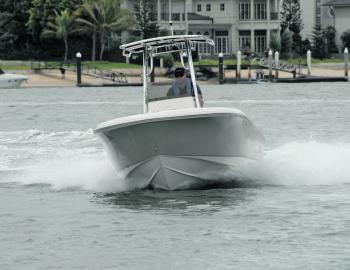
The complex hull shape of the Pioneer centre console is exclusive to fibreglass construction. Here it’s displacing water very cleanly in a turn to starboard.

A lesson in hull design, the fibreglass Pioneer sports a hull shape that cannot be achieved with alloy. Note that prominent reversed water line chine.
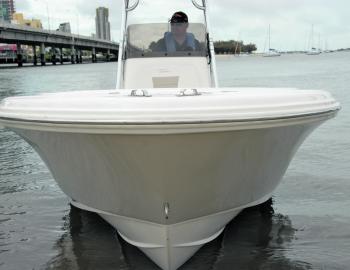
Fibreglass hulls have the smooth ride. A look at the bow section of this craft certainly shows the complexity of design that contributes to this fact.
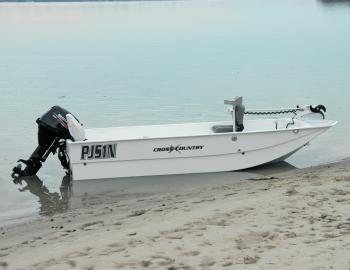
With ultra light glass the Cross Country car topper combines rigidity, strength and a very user-friendly weight.
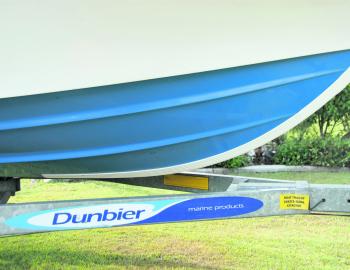
The Keel Shield on the author’s 5.5m glass hull allowed the craft to be drawn onto ramps or other rough areas with impunity.
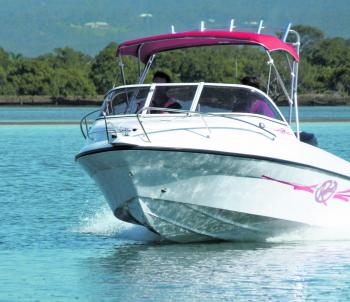
Function follows fine form: note the very well designed bow and upper sections of this glass half cabin rig.
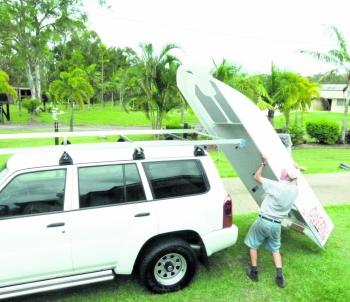
The ultra light weight of infused glass craft makes them ideal for car top travel. How many craft of this size are so easily loaded by one person!

When it comes to involved hull shapes for specialized performance work fibreglass is in a realm of its own.




